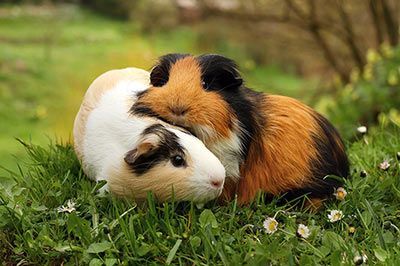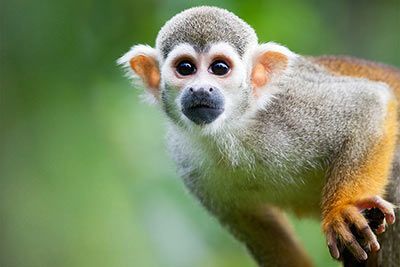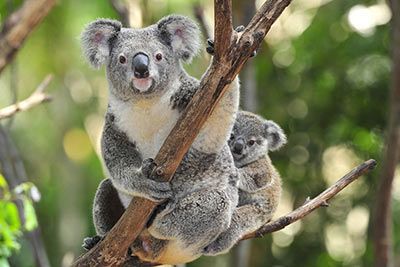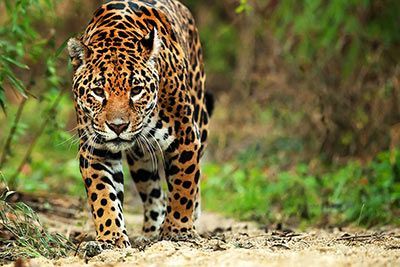Okapi
Okapi Facts
| Size | 5 feet (1.5 m) |
| Speed | Up to 37 mph (60 km/h) |
| Weight | 440-770 pounds (200-350 kg) |
| Lifespan | 20-30 years |
| Food | Leaves, herbs, fruits, grasses |
| Predators | Leopards, serval cats |
| Habitat | Central Africa |
| Order | Even-toed ungulates |
| Family | Giraffidae |
| Scientific name | Okapia johnstoni |
| Characteristics | Forest giraffe with long neck and striped legs |
Main Characteristics
The okapi is a forest giraffe that lives in central Africa in the Ituri rainforest of the Democratic Republic of Congo. It is a shy loner. Its most striking features are their striped legs, their long neck and the ossicones on their heads. It looks like a mix of a giraffe and a zebra. It is very rare and was only discovered in 1901.
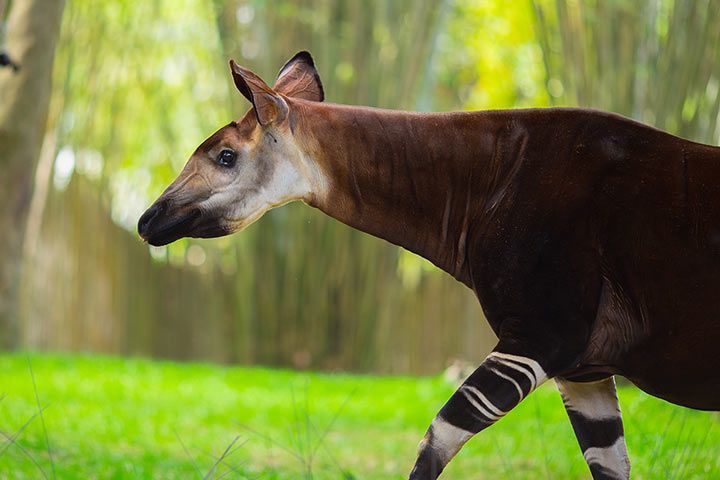
Species
Is the okapi a cross between a giraffe and a zebra? No, the okapi is not a cross between the two animal species. Actually, it only shares stripes with the zebra. Instead, it is closely related to the giraffe. Both species have common ancestors.
Name
What does the name okapi mean? It derives from the word “o'api” from one of the central Sudanic languages. It is made up of two words: “oka” for “cutting” and “kpi” for an arrow. You could say "cutting arrow". The reason that led to its name were the striped patterns on their legs.
Distribution and Habitat
Okapis only exist in the wild in the Democratic Republic of Congo. The majority lives in the tropical Ituri rainforest in the northeast of the country.
Life Style
Okapis are active during the day and at night. They spend most of their time looking for food or a mate. They usually stay in a small area of 2-4.5 square miles (5-12 km²).

Anatomy and Appearance
Size and Weight
Okapis have a shoulder height of 5 feet (1.5 meters), a body length of 8 feet (2.5 meters) and a weight of 440-770 pounds (200-350 kg). They are much smaller than giraffes and thus can navigate through dense rainforest more easily.
Coat
Okapis have dark, horizontal stripes on their white front and hind legs. Their noses and cheeks are light-colored. The rest of their coat ranges from reddish brown to dark brown in color.
Tongue
Okapis possess a 18 inches (45 cm) long black tongue. It is prehensile and perfect to grasp leaves. They're among the few animals in the world that can clean their ears and eyes with their tongue.
Ossicones
Male okapis have two horn-like ossicones on their heads. They grow up to 6 inches (15 cm) long. Females don't have ossicones.
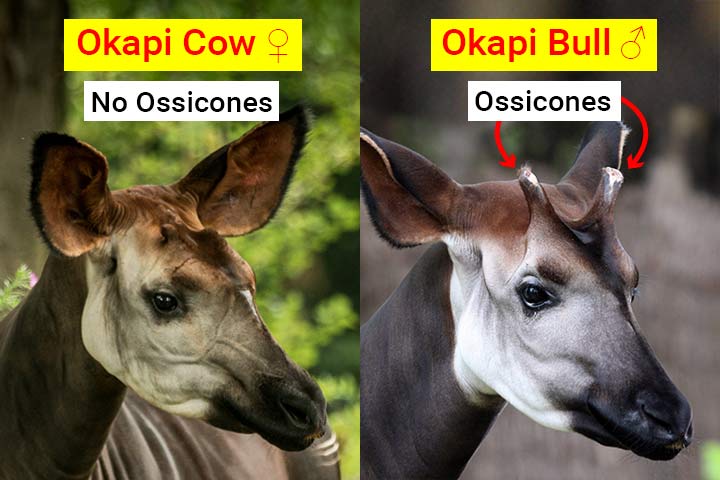
Okapi or Giraffe - What's the Difference?
Okapis and giraffes are closely related. And yet there are big differences. Okapis are smaller, lighter, have a shorter neck, larger ears and striped markings on their legs. Only the males have ossicones. They live exclusively in the Congo. Giraffes, on the other hand, are four times as heavy, four times as tall, have a longer neck, and patches instead of stripes. Both sexes have horns. They live in South and East Africa.
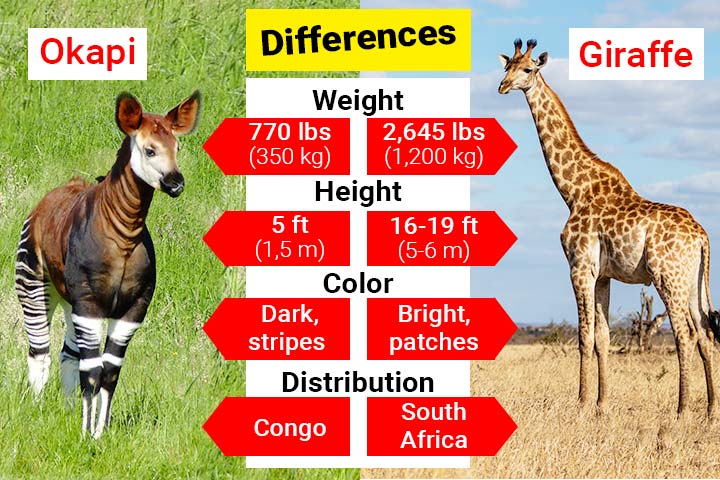
Okapi or Zebra - What's the Difference?
Okapis and zebras have a similar appearance. Nevertheless, the animals are very different. Okapis only have stripes on their legs. They're even-toed ungulates. ruminants and live a solitary life. Zebras, on the other hand, have stripes everywhere. They're odd-toed ungulates, no ruminants and prefer to live in large herds.
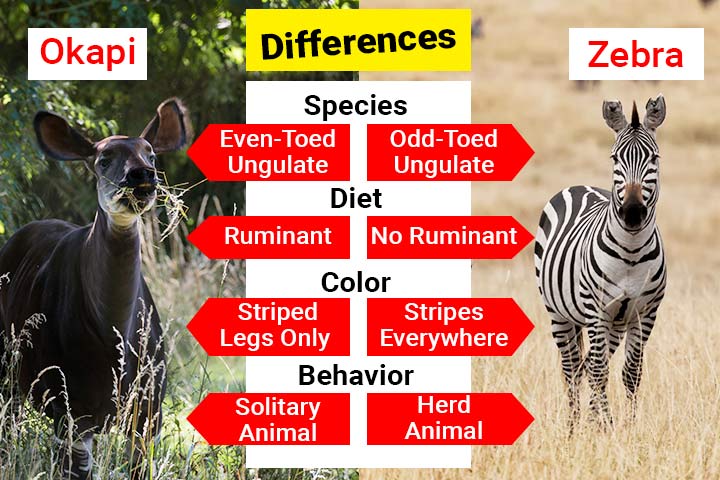
Diet
Okapis are herbivores. They feed on leaves that they pluck from branches with their long tongues. They also eat twigs, grasses, ferns, fruits, and mushrooms. From time to time they like to lick clay to absorb minerals and salts. They are ruminants, meaning they chew their food twice.
Behavior
Sleeping
Okapis are among the animals in the world that sleep the least. During the day they close their eyes for five minutes at a time. In total, they snooze two hours a day. During their naps they fall into a 30-second deep sleep phase up to ten times. Okapis sleep very briefly, but deeply.
Drinking
Okapis have a long neck, but can't reach the ground with their head - just like giraffes. If they want to drink, they have to spread their front legs wide. This way they can lower their body and bend down far enough.
Fighting
Males often engage in battles to establish their own territory or to improve their mating opportunities with females. They use their neck to gain momentum and hit their rival's neck with their head - just like giraffes.
How Do Okapis Defend Themselves?
Okapis defend themselves from leopards by using strong kicks, but young, old, or weak individuals are usually overpowered. They rely on their stripes for camouflage and their keen sense of hearing to detect threats and flee before being caught.
Are Okapis Dangerous?
When two male okapis fight with each other, they can become quite aggressive. However, they're very reserved and wary of humans. They keep their distance and would rather flee than engage with us.

Senses and Abilities
Sense of Hearing
Okapis have an excellent sense of hearing. Unlike giraffes, okapis have much larger and more flexible ears. Their ears enable them to hear even the slightest sounds.
Sense of Smell
Okapis possess a strong sense of smell. They use it to locate fresh leaves and to keep track of their fellow species. They also have scent glands on their hooves, allowing them to leave a scent trail with each step.
Communication
Okapis communicate with their peers using sounds. They whistle, bleat, snort and moan. They also use infrasound for communication. Infrasound is a very low frequency that is way too low for human ears. Even leopards - the okapi's predators - can't hear these sounds.

Life Expectancy
How long do okapis live? The oldest okapi became 33 years old, but it lived at a zoo. Out in the wild they can live for about 15-20 years. However, they rarely live that long because they are killed by hunters beforehand.
Enemies and Threats
Natural Enemies
In the wild, the leopard is the only predator that okapis have to fear.
Hunting and Poaching
It has been illegal to hunt and kill okapis since 1933. Nevertheless, the animals are still killed by poachers. Their meat and skin are highly sought after and fetch high prices. Unfortunately, this has led to the species now being seriously endangered.
Population
How many okapis are left? Since the okapi is a shy, solitary animal, the number of animals can only be roughly estimated. According to IUCN information from 2015, there are probably 10,000-35,000 animals. There are no more current figures (as of March 2024). Therefore, the okapi is classified by the IUCN as an endangered species.
Importance for the Ecosystem
Okapis feed on around 100 different plants, fruits and fungi and spread their seeds and spores on the rainforest floor via their droppings. By doing so, they contribute to the growth of new plants.
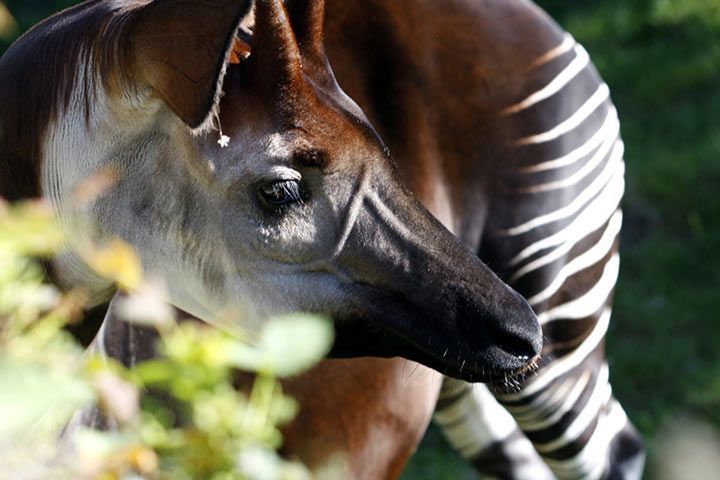
Reproduction
Mating Ritual
Okapis don't have a specific season in which they mate. The mating ritual involves the male circling the female. He sniffs her, licks her neck, shows his neck and extends a leg towards her. If she agrees, the animals will mate.
Gestation Period and Birth
A baby okapi is born after a gestation period of 440-450 days, weighing between 14-30 kg. Like many ungulates, the babies can stand on their own two feet about 30 minutes after their birth. The mother hides her young in the thicket for the first few weeks so that it can grow up in safety. In male animals, the horns begin to grow after about a year. The animals are fully grown at around two to three years of age.
Can Okapis and Giraffes Crossbreed?
A cross between an okapi and a giraffe would be exciting. What would be its name, okapiraffe, girakapi? And what would it look like? However, the genetic makeup of the two species is so different that we will never find out. They are unable to reproduce with each other. It's the same with the zebras. Their genetic makeup is too different.
Discovery
The okapi likes to hide, but despite its size, it was only discovered in 1887 by the famous African explorer Henry Stanley. The species was officially described and called Okapi in 1901 for the first time.
The Okapi Is Related To:
Animals in the Same Biome:
- Find Out More:
- Animals That Sleep the Most
- Watch Now on animalfunfacts.net:
 Rainforest Animals
Rainforest Animals














